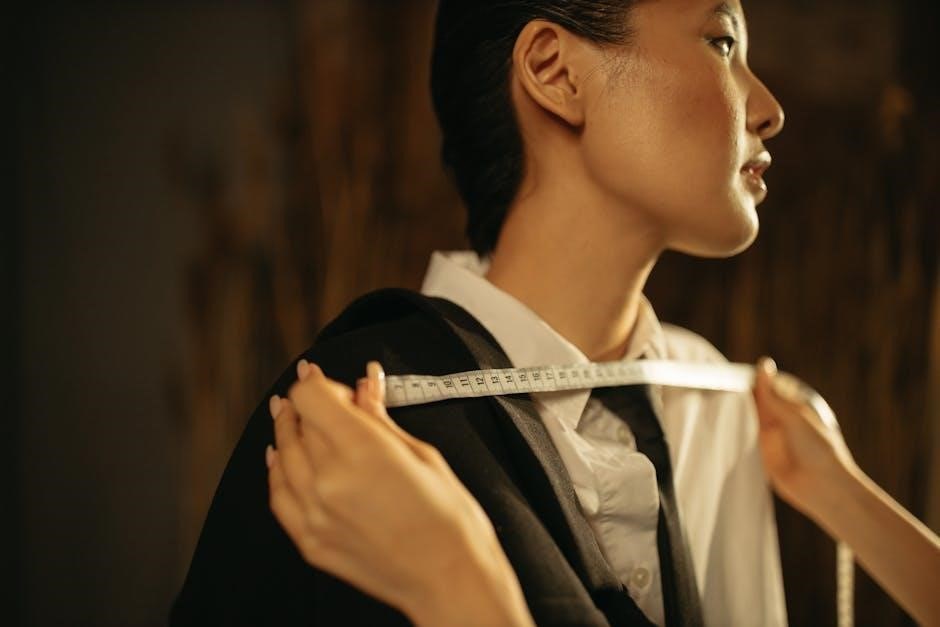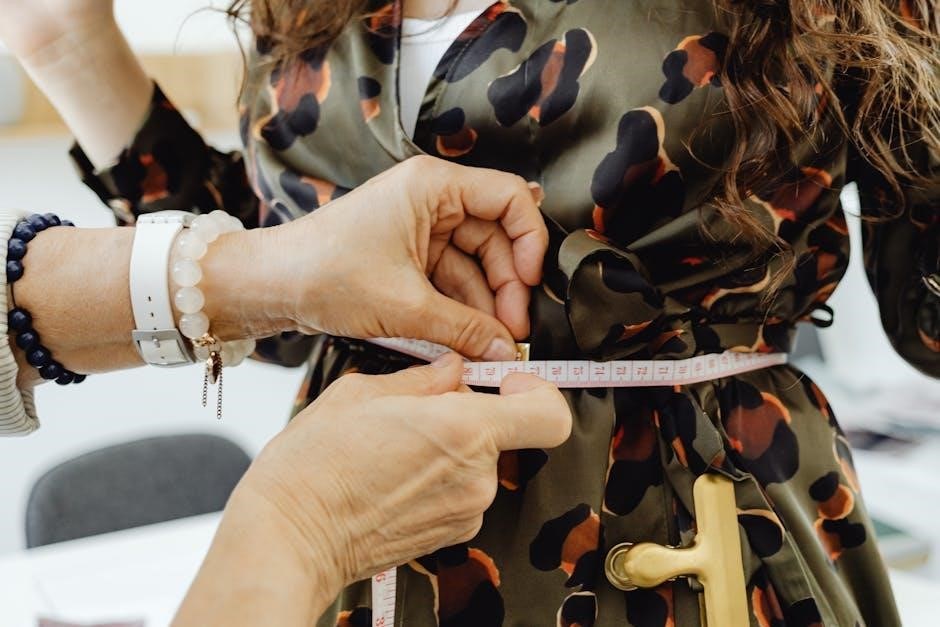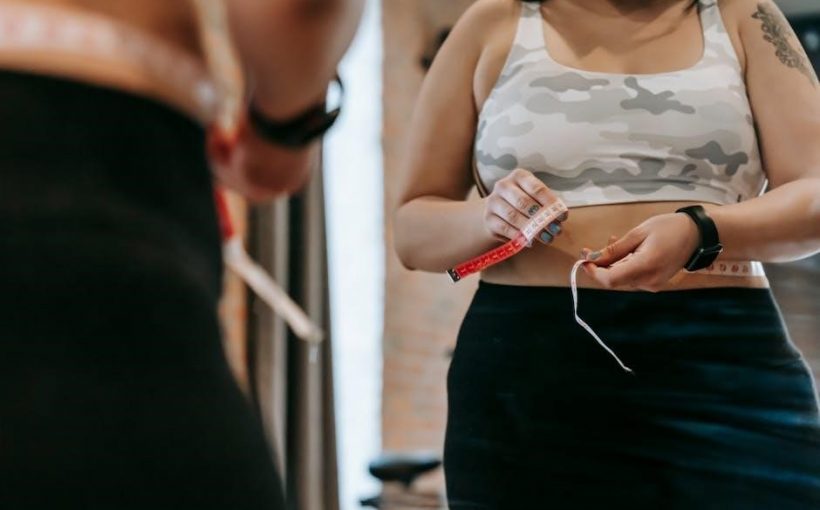Welcome to the Clothing Measurement Guide, your comprehensive resource for achieving perfect fits. Learn how to measure yourself accurately, understand size charts, and ensure flawless clothing fits every time.
1.1 Importance of Accurate Measurements
Accurate measurements are crucial for ensuring a perfect fit in clothing. They help prevent issues like sleeves being too long or pants too short, saving time and money on alterations. Proper measurements also reduce the need for returns and exchanges, especially when shopping online. By taking precise measurements, you can confidently select sizes that flatter your body and ensure comfort.
1.2 Purpose of the Guide
This guide provides a comprehensive approach to understanding clothing measurements, ensuring a perfect fit for all body types. It teaches how to measure accurately, interpret size charts, and convert sizes between systems. The guide helps avoid common fit issues and makes online shopping easier by providing clear, step-by-step instructions for measuring and selecting the right sizes.

Tools Needed for Measuring
A flexible measuring tape, full-length mirror, and basic tools like a ruler, pen, and paper are essential for accurate body and garment measurements.
2.1 Flexible Measuring Tape
A flexible measuring tape is essential for accurate body measurements. It allows you to wrap around curved areas like the bust, waist, and hips without slipping. Look for a soft, fabric-covered tape for comfort and ease of use. Ensure the tape is level and not twisted for precise results. This tool is vital for achieving a perfect fit in clothing.
2.2 Full-Length Mirror
A full-length mirror is crucial for ensuring accurate measurements, allowing you to see the tape measure’s placement clearly. It helps maintain proper posture and alignment, ensuring the tape isn’t twisted or misplaced. This tool is essential for verifying measurements visually, especially when measuring hard-to-reach areas like the shoulders or waist, ensuring consistency and precision in your clothing fit.
2.4 Additional Tools (Ruler, Pen, Paper)
A ruler is useful for measuring flat surfaces, like fabric or existing garments. A pen and paper are essential for recording your measurements accurately. These tools help ensure precision and allow you to refer back to your measurements when shopping or sewing. They complement the tape measure, providing a complete setup for accurate clothing measurements and fit assessments.

Key Body Measurements for Clothing
Accurate body measurements are crucial for a perfect fit. Measure bust, waist, hips, inseam, outseam, shoulder width, and sleeve length to ensure comfort and style in your clothing.
3.1 Bust Measurement
Wrap the tape measure around the fullest part of your bust, keeping it level and parallel to the floor. This measurement is crucial for determining sizes of tops, dresses, and jackets. Ensure the tape isn’t too tight or loose for accurate results, and consider wearing a fitted bra or top for consistency.
3.2 Waist Measurement
To measure your waist, locate the natural waistline, typically the narrowest point above your hips. Wrap the tape measure around it, keeping it level and snug but not too tight. This measurement is essential for sizing bottoms, belts, and tailored garments. Stand up straight and wear form-fitting clothing for accuracy. Ensure the tape is parallel to the floor for consistent results.
3.3 Hip Measurement
To measure your hips, stand upright and place the tape measure around the widest part of your hips, typically 7-9 inches below your waistline. Ensure the tape is level and snug but not too tight. This measurement is crucial for fitting pants, skirts, and dresses. Wear form-fitting clothing and keep the tape parallel to the floor for accuracy.
3.4 Inseam and Outseam
Measure your inseam by placing the tape from the crotch seam to the bottom of your foot. For outseam, measure from the top of the waistband to the bottom of the pant hem. These measurements ensure proper pant and skirt lengths. Stand straight, keep the tape snug, and avoid wrinkles for accurate results.
3.5 Shoulder Width
Measure your shoulder width by placing the tape from the edge of one shoulder to the other, across the back. Stand straight, keep the tape level, and ensure it’s not twisted. The measurement should be taken over a thin layer of clothing for accuracy. This ensures proper fit for jackets, shirts, and other garments. Accuracy is key for tailored pieces.
3.6 Sleeve Length
Measure sleeve length from the center back of your neck, over your shoulder, and down to your wrist. Keep your arm slightly bent for comfort. The tape should follow your natural arm contour. This ensures sleeves fit perfectly, avoiding restriction or excess fabric. Accuracy here guarantees comfort and a polished look in jackets, shirts, and coats.

Troubleshooting Common Fit Issues
Address common discomfort and distortion by resolving issues like shoulders too tight, sleeves too long, trousers too long, and jacket length problems for a perfect fit.
4.1 Shoulders Too Tight
If the shoulders feel too tight, it restricts movement and causes discomfort. To fix this, consider sizing up or adjusting the garment’s fit. Simple alterations, like letting out seams or adding a small dart, can provide relief without compromising the overall appearance. Proper shoulder alignment ensures both comfort and a polished look in your clothing;
4.2 Sleeves Too Long or Short
If sleeves are too long or short, they can be easily adjusted by a tailor. This simple fix ensures optimal comfort and style. To avoid the issue, always measure the sleeve length accurately, ensuring it aligns with your body proportions for a perfect fit.
4.3 Trousers Too Long
Trousers that are too long can create an unbalanced look. A simple solution is to hem the bottoms to the desired length. This minor alteration ensures a polished appearance and proper fit. Accurate inseam measurements can help prevent this issue, but a quick trip to a tailor offers an easy fix for overly long trousers.
4.4 Jacket Length Issues
Jacket length issues can affect both style and fit. If the jacket is too long or short, it may not align with your body proportions. To resolve this, ensure accurate measurements before purchasing. Consider consulting a size chart or tailoring for adjustments to achieve the perfect fit.

Using Clothing Size Charts
Clothing size charts are essential tools for ensuring accurate fits. They provide standardized measurements, helping you choose the right size and reduce the need for returns.
5.1 Understanding Size Charts
Clothing size charts are detailed tables that map body measurements to corresponding garment sizes. They vary by brand and region, so understanding them is crucial for selecting the right fit. Accurate measurements ensure proper sizing, reducing the likelihood of ill-fitting clothing and the hassle of returns. Always refer to the chart specific to the brand and garment type for the best results.
5.2 Converting Between Sizing Systems
Converting between sizing systems is essential for international shopping. US, EU, and UK sizes differ significantly. Use a reliable size chart or converter tool to align your measurements with the target system. Double-checking ensures accuracy and avoids sizing errors. Always refer to brand-specific guides for the most precise conversions and a perfect fit every time.

Measuring for Specific Clothing Types
Measurements vary by clothing type. Tops require bust and shoulder measurements, while bottoms need waist and inseam. Dresses combine bust, waist, and hip measurements for a perfect fit.
6.1 Measuring for Tops
For tops, measure the bust by wrapping the tape around the fullest part, keeping it level and parallel to the floor. For sleeve length, measure from the shoulder to the wrist. Ensure the tape is snug but not tight for accurate sizing. This ensures a comfortable and flattering fit for various top styles.
6.2 Measuring for Bottoms
For bottoms, measure the waist at the narrowest point, hips around the fullest part, and inseam from crotch to ankle. Wrap the tape measure snugly, keeping it level. Ensure accurate fit by avoiding tightness. Use a mirror to verify proper placement. This ensures the perfect fit for pants, skirts, and shorts.
6.3 Measuring for Dresses
Measure the bust at the fullest point, keeping the tape level. For waist, measure at the narrowest point. Hips are measured around the fullest part, typically 7-9 inches below the waist. Check the dress length from the shoulder to the desired hemline. Use a mirror to ensure accuracy and keep the tape snug but not tight for a perfect fit.
6.4 Measuring for Outerwear
Measure chest, waist, and shoulders for jackets and coats. Ensure the tape is level and snug. Sleeve length is measured from the shoulder to wrist. Check jacket length to ensure it aligns with your hip or thigh for the desired fit; Use a mirror to verify accuracy and ensure the garment fits comfortably over other clothing.
Converting Measurements Between Systems
Understand international size differences and use conversion charts to align your measurements with global standards, ensuring accurate fits across various regions and brands.
7.1 International Size Conversions
International size conversions are essential for global shopping; Use standardized charts to align your measurements with European, American, or Asian sizing systems. Understand that sizes vary by region and brand. For accuracy, refer to official conversion guides or brand-specific charts. Double-check measurements to ensure the best fit when shopping across borders or from international retailers.
7.2 European vs. American Measurements
European and American sizing systems differ significantly. European sizes often use numerical measurements based on centimeters, while American sizes follow a letter-based scale. Understanding these differences is crucial for accurate fit. Always refer to brand-specific charts, as exact conversions may vary. This ensures you select the correct size when shopping across regions or brands.

Measuring for Others
Measuring others requires patience and clarity. Use a flexible tape measure, keep it level, and ensure the person stands naturally. Communicate instructions clearly for accurate results.
8.1 Tips for Measuring Someone Else
Ensure accuracy and comfort when measuring others. Position the tape measure correctly, keeping it level and snug but not tight. For shoulder width, measure across the back from one shoulder tip to the other. For bust, wrap the tape around the fullest part. Guide the tape gently down the arm for sleeve length. Always measure over fitted clothing and maintain a neutral posture for precise results.
8.2 How to Assist Accurately
When assisting someone with measurements, ensure the tape is level and snug but not tight. Stand at their height and guide the tape smoothly around their body. For accurate sleeve length, extend their arm slightly and wrap the tape from the shoulder to wrist. Maintain a neutral posture and double-check measurements for consistency. Communication is key for precise results.
Maintaining Fit Over Time
Regularly monitor body changes due to lifestyle or health factors. Adjust measurements periodically to ensure clothing fits well and remains comfortable over time.
9.1 How Body Measurements Change
Body measurements naturally fluctuate due to factors like weight changes, aging, muscle gain, or posture shifts. Key areas affected include waist, hips, and bust. These changes can occur gradually, making regular measurement updates essential for maintaining accurate sizing.
Hormonal shifts, lifestyle adjustments, and health conditions also influence measurements. Staying attuned to these changes ensures a consistent, comfortable fit in your clothing over time.
9.2 Adjusting Measurements Periodically
Regularly updating your measurements ensures optimal fit and comfort in your clothing. Life changes, such as weight fluctuations or posture adjustments, can alter your body dimensions over time. It’s recommended to remeasure every six to twelve months to account for these shifts.
Keeping track of changes in key areas like waist, hips, and bust helps maintain accurate sizing. This practice ensures your clothes continue to fit well and look their best, adapting to your evolving body shape and lifestyle.
Avoiding Common Measurement Mistakes
Avoid common errors like incorrect tape placement or uneven measurements. Ensure the tape is level and snug but not tight. Accurate measurements are key to proper sizing.
10.1 Incorrect Placement of Tape Measure
One of the most common mistakes is misplacing the tape measure. Ensure it sits level and snug, neither too tight nor too loose. For accurate results, avoid slouching or twisting. Place the tape at the correct anatomical landmarks, such as the fullest part of the bust or natural waistline. Double-check positioning to avoid skewed measurements that lead to poor fits.
10.2 Not Keeping the Tape Measure Level
Failing to keep the tape measure level is a frequent error. Ensure it remains horizontal and parallel to the floor. Tilting the tape can lead to inaccurate readings, affecting garment fit. Always maintain a consistent plane, whether measuring the bust, waist, or hips, to guarantee precise and reliable results for optimal clothing fit.
